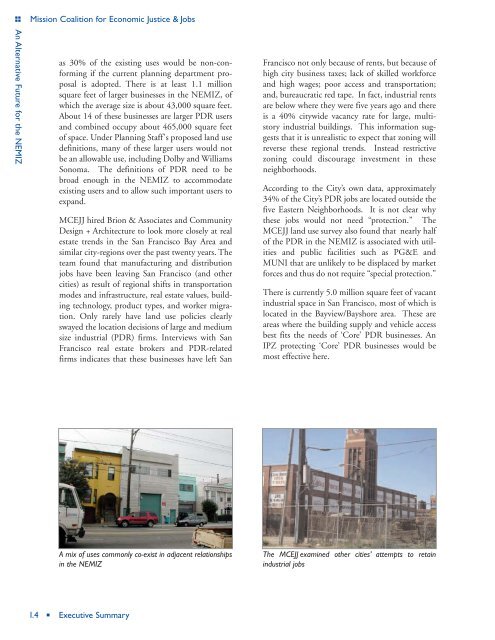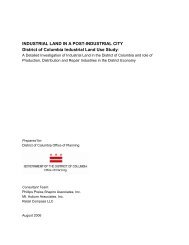An Alternative Future for the North East Mission Industrial Zone
An Alternative Future for the North East Mission Industrial Zone
An Alternative Future for the North East Mission Industrial Zone
Create successful ePaper yourself
Turn your PDF publications into a flip-book with our unique Google optimized e-Paper software.
<strong>An</strong> <strong>Alternative</strong> <strong>Future</strong> <strong>for</strong> <strong>the</strong> NEMIZ<br />
<strong>Mission</strong> Coalition <strong>for</strong> Economic Justice & Jobs<br />
as 30% of <strong>the</strong> existing uses would be non-con<strong>for</strong>ming<br />
if <strong>the</strong> current planning department proposal<br />
is adopted. There is at least 1.1 million<br />
square feet of larger businesses in <strong>the</strong> NEMIZ, of<br />
which <strong>the</strong> average size is about 43,000 square feet.<br />
About 14 of <strong>the</strong>se businesses are larger PDR users<br />
and combined occupy about 465,000 square feet<br />
of space. Under Planning Staff's proposed land use<br />
definitions, many of <strong>the</strong>se larger users would not<br />
be an allowable use, including Dolby and Williams<br />
Sonoma. The definitions of PDR need to be<br />
broad enough in <strong>the</strong> NEMIZ to accommodate<br />
existing users and to allow such important users to<br />
expand.<br />
MCEJJ hired Brion & Associates and Community<br />
Design + Architecture to look more closely at real<br />
estate trends in <strong>the</strong> San Francisco Bay Area and<br />
similar city-regions over <strong>the</strong> past twenty years. The<br />
team found that manufacturing and distribution<br />
jobs have been leaving San Francisco (and o<strong>the</strong>r<br />
cities) as result of regional shifts in transportation<br />
modes and infrastructure, real estate values, building<br />
technology, product types, and worker migration.<br />
Only rarely have land use policies clearly<br />
swayed <strong>the</strong> location decisions of large and medium<br />
size industrial (PDR) firms. Interviews with San<br />
Francisco real estate brokers and PDR-related<br />
firms indicates that <strong>the</strong>se businesses have left San<br />
A mix of uses commonly co-exist in adjacent relationships<br />
in <strong>the</strong> NEMIZ<br />
I.4 Executive Summary<br />
Francisco not only because of rents, but because of<br />
high city business taxes; lack of skilled work<strong>for</strong>ce<br />
and high wages; poor access and transportation;<br />
and, bureaucratic red tape. In fact, industrial rents<br />
are below where <strong>the</strong>y were five years ago and <strong>the</strong>re<br />
is a 40% citywide vacancy rate <strong>for</strong> large, multistory<br />
industrial buildings. This in<strong>for</strong>mation suggests<br />
that it is unrealistic to expect that zoning will<br />
reverse <strong>the</strong>se regional trends. Instead restrictive<br />
zoning could discourage investment in <strong>the</strong>se<br />
neighborhoods.<br />
According to <strong>the</strong> City’s own data, approximately<br />
34% of <strong>the</strong> City’s PDR jobs are located outside <strong>the</strong><br />
five <strong>East</strong>ern Neighborhoods. It is not clear why<br />
<strong>the</strong>se jobs would not need “protection.” The<br />
MCEJJ land use survey also found that nearly half<br />
of <strong>the</strong> PDR in <strong>the</strong> NEMIZ is associated with utilities<br />
and public facilities such as PG&E and<br />
MUNI that are unlikely to be displaced by market<br />
<strong>for</strong>ces and thus do not require “special protection.”<br />
There is currently 5.0 million square feet of vacant<br />
industrial space in San Francisco, most of which is<br />
located in <strong>the</strong> Bayview/Bayshore area. These are<br />
areas where <strong>the</strong> building supply and vehicle access<br />
best fits <strong>the</strong> needs of ‘Core’ PDR businesses. <strong>An</strong><br />
IPZ protecting ‘Core’ PDR businesses would be<br />
most effective here.<br />
The MCEJJ examined o<strong>the</strong>r cities’ attempts to retain<br />
industrial jobs












